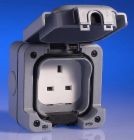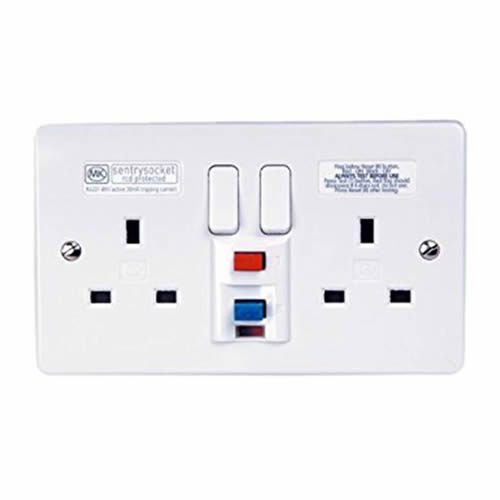Wiring Different plug types
This page contains links to the following circuit diagrams
This page contains links to the following circuit diagrams
Using Power Outdoors.
When power is required for the shed, patio, garden pond or other out of doors purpose, a separate circuit from the consumer unit should be used.
Where a Residual Current Device (RCD) is not already fitted before the consumer unit, one should be installed.
The Residual Current Device will switch off the electricity almost instantaneously if a fault develops in the circuit.
Waterproof sockets must be used where an outside socket is required, an internal control switch is also recommended so that the outside socket can be isolated if necessary.

How to protect yourself while out in the garden using an RCD device
What is an RCD?
An RCD, or residual current device, is a life-saving device which is designed to prevent you from getting a fatal electric shock if you touch something live, such as a bare wire. It can also provide some protection against electrical fires. RCDs offer a level of personal protection that ordinary fuses and circuit-breakers cannot provide.
What does an RCD do?
An RCD is a sensitive safety device that switches off electricity automatically if there is a fault.
An RCD is designed to protect against the risks of electrocution and fire caused by earth faults. For example, if you cut through the cable when mowing the lawn and accidentally touched the exposed live wires or a faulty appliance overheats causing electric current to flow to earth.
How does it work?
An RCD constantly monitors the electric current flowing through one or more circuits it is used to protect. If it detects electricity flowing down an unintended path, such as through a person who has touched a live part, the RCD will switch the circuit off very quickly, significantly reducing the risk of death or serious injury.
What are the main types of RCD?
RCDs can help protect you from electric shock in potentially dangerous areas like bathrooms and gardens, and there are various types of RCDs that can be used to make sure you are always as safe as possible.There are a number of alternatives to using mains electricity in the garden, low voltage garden lights and appliances are available to reduce the risk of using electricity out of doors.
These are special socket-outlets with an RCD built into them which can be used in place of a standard socket-outlet. This type of RCD provides protection only to the person in contact with equipment, including its lead, plugged into the special socket-outlet.

Portable RCDs
These plug into any standard socket-outlet. An appliance can then be plugged into the RCD. They are useful when neither fixed nor socket-outlet RCDs are available but, as with socket-outlet RCDs, they provide protection only to the person in contact with the equipment, including its lead, plugged into the portable RCD.

Are RCDs reliable?
We’ve found that fixed RCDs are about 97% reliable. This improves if they are tested regularly. If you have fixed RCD protection, it will reduce the risk of electric shock to you and your family. It can also protect your home against the risk of fire caused by faulty wiring or appliances.Remember – Although RCD protection reduces the risk of death or injury from electric shock it does not reduce the need to be careful.
Have your wiring checked at least once every 10 years to ensure the safety of you, your family and your home. If you find a fault with your wiring, or an appliance, stop using it immediately and contact a registered electrician.
Don’t forget to test – You should test all fixed and socket RCDs about every three months. Manufacturers recommend that portable RCDs are tested every time you use them.
Beware – If you hold the test button in for a long time and the RCD does not switch off the electricity supply, then get advice from a registered electrician.
The UK standard for safety – Since July 2008 virtually all circuits in new or rewired homes have been required to include an RCD under the latest edition of BS 7671.
How do I check whether I already have fixed RCD protection?
To check if you have fixed RCD protection, go to your consumer unit and have a look to see if there is a device with a pushbutton marked ‘T’ or ‘Test’. This ‘test’ button is part of an RCD. If an RCD is fitted, there should also be a label on or near the consumer unit stating ‘test quarterly’.
D i s c l a i m e r
Whether you're starting a fresh or a competent electrical person, be sure to read and study the following pages, if you have further questions please consult a qualified electrician, it's better safe than sorry -
Don't forget - Electricity KILLS....